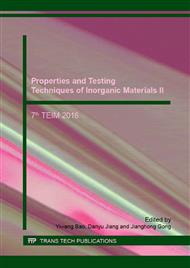p.115
p.120
p.127
p.132
p.137
p.143
p.148
p.153
p.159
Effects of Fiber Pre-Oxidation on Mechanical Properties and Microstructure of T700 Carbon Fiber Reinforced Mini C/SiC Composites
Abstract:
The reainforcement of T700 carbon fiber was oxidized at 400°C, as-received and treated carbon fiber reinforced mini Cf/SiC matrix composites were fabricated by precursor infiltration and pyrolysis (PIP) method. The mechanical properties of the composites were determined and compared. The results showed that with the time of oxidation increased, the flexural strength of composites decreased. The flexural modulus and tensile modulus were increased by the 87.8 GPa to 92.9 GPa and 131 GPa to 150 GPa. Without oxidation pretreatment, the composites represented maximum flexural strength of 649 MPa. For 1h oxidation, the composites reached the maximum tensile strength of 821 MPa. However, carbon fiber pre-oxidation for 2h, C/SiC composites mechanical properties appeared to reduce seriously.
Info:
Periodical:
Pages:
137-142
Citation:
Online since:
January 2017
Authors:
Keywords:
Price:
Сopyright:
© 2017 Trans Tech Publications Ltd. All Rights Reserved
Share:
Citation:


